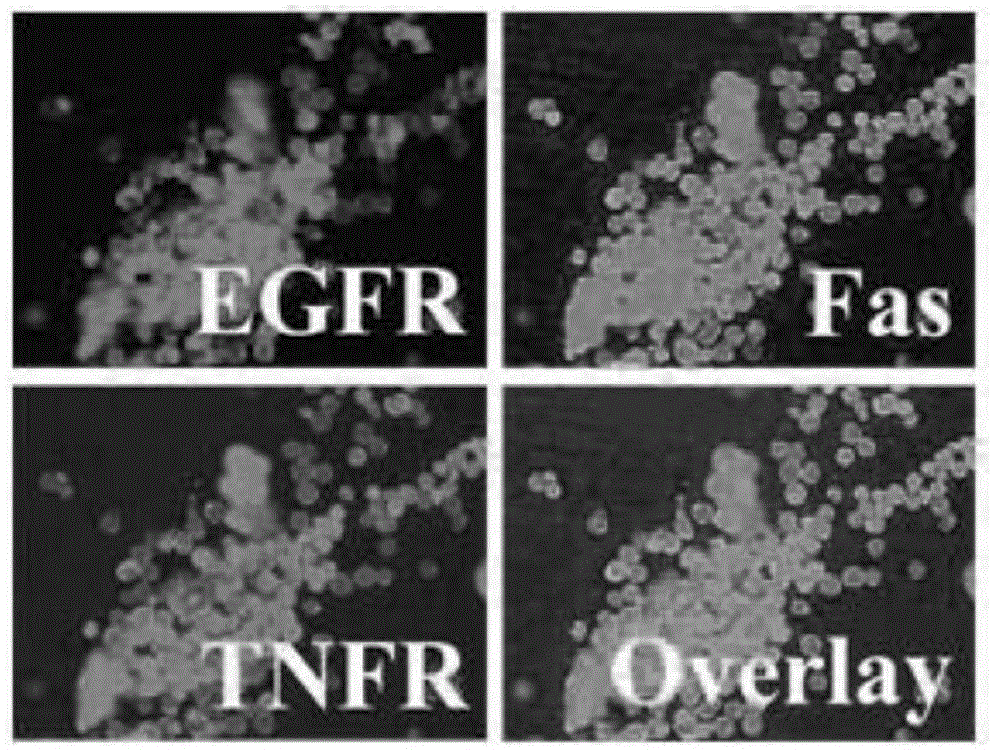Screening method of active component in multiple target point anti-tumor traditional Chinese medicine and application thereof
An active component and multi-target technology, which is applied in antineoplastic drugs, separation methods, medical preparations containing active ingredients, etc., can solve problems such as low efficiency, unsatisfactory results, and long time-consuming
- Summary
- Abstract
- Description
- Claims
- Application Information
AI Technical Summary
Problems solved by technology
Method used
Image
Examples
Embodiment 1
[0034] Example 1: Preparation of silica gel column for screening of natural active components of multi-target anti-tumor traditional Chinese medicine
[0035] (1) Culture and expansion of MCF-7 cells:
[0036] MCF-7 cells were cultured and expanded with DMEM medium containing 10% calf serum (NBS), and the cell number concentration was adjusted to 1×10 7 pcs / ml, spare;
[0037] (2) Extraction of multi-target receptor enrichment region:
[0038] Add the lysate containing detergent to the MCF-7 cells collected in (1), and extract the multi-target receptor enrichment area; then use the sucrose density gradient centrifugation method to separate the receptor enrichment area, and the sucrose-containing The suspension of the receptor-enriched region was placed in 80 mM Tris-HCL solution with pH 7.2 at 4°C, dialyzed for 24 hours, and the solution containing the multi-target receptor-enriched region was placed in a -80°C refrigerator for later use.
[0039] (3) Preparation of silica ...
Embodiment 2
[0041] Example 2: Preparation of a chromatographic column for screening of natural active components of multi-target anti-tumor traditional Chinese medicine
[0042] (1) Culture and expansion of MCF-7 cells:
[0043] MCF-7 cells were cultured and expanded in DMEM medium containing 10% calf serum (NBS), and the cell number concentration was adjusted to 10×10 7 pcs / ml, spare;
[0044] (2) Extraction of multi-target receptor enrichment region:
[0045] Add the lysate containing detergent to the MCF-7 cells collected in (1), and extract the multi-target receptor enrichment area; then use the sucrose density gradient centrifugation method to separate the receptor enrichment area, and the sucrose-containing The suspension of the receptor-enriched region was placed in 120 mM Tris-HCL solution with pH 7.5 at 4°C, dialyzed for 20 hours, and the solution containing the multi-target receptor-enriched region was placed in a -80°C refrigerator for later use.
[0046] (3) Preparation of ...
Embodiment 3
[0048] Example 3: Identification of multi-target receptor modified silica gel stationary phase
[0049] Take the suspension of the silica gel stationary phase prepared above for the screening of natural active components of multi-target anti-tumor traditional Chinese medicine, add 200 μL of the primary antibody dilution (1:100) of EGFR, TNFR and Fas, and different fluorescent secondary antibodies respectively. Anti-dilution solution (1:500), observe the results under an inverted fluorescence microscope. The results observed under the fluorescence microscope were figure 2 , all the surface-specific fluorescence of silica gel stationary phase microspheres modified by multi-target receptors is uniform and bright. The experimental results showed that EGFR, Fas and TNFR were successfully connected on the silica gel stationary phase.
PUM
 Login to View More
Login to View More Abstract
Description
Claims
Application Information
 Login to View More
Login to View More - R&D Engineer
- R&D Manager
- IP Professional
- Industry Leading Data Capabilities
- Powerful AI technology
- Patent DNA Extraction
Browse by: Latest US Patents, China's latest patents, Technical Efficacy Thesaurus, Application Domain, Technology Topic, Popular Technical Reports.
© 2024 PatSnap. All rights reserved.Legal|Privacy policy|Modern Slavery Act Transparency Statement|Sitemap|About US| Contact US: help@patsnap.com










